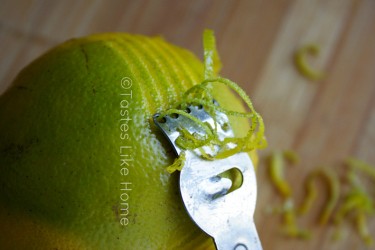Hi Everyone, Looking to brighten and perk up your food and beverage? Add a little zest! I don’t mean enthusiasm, zeal and passion – although those won’t hurt – I am talking about citrus zest.
Zest is the outer coloured part of the peel of any citrus fruit. It’s the yellow in the lemon, the green in the lime, the orange in the tangerine or orange depending on the variety you buy. Grapefruit and other citrus fruits provide a variety of options to acquire highly fragrant, aromatic and flavourful zest. The more flavour a fruit has, the more profound is the flavour of its zest. Now, don’t get confused here with zest and orange peel (or any other dried citrus peel). Zest only contains the essential flavour oils of the outer skin. The peels on the other hand contain the pith (the white part beneath the coloured skin), which is bitter. Therefore, when removing the zest, it is important to not get any of the pith.
 To really grasp what that essential oil is, do this: take a lime or lemon and roll it on any surface to soften, making it easy to juice when cut. Now hold up the lime or lemon, and look at it. See how shiny and oily it is? That is what is captured when you zest any citrus fruit.
To really grasp what that essential oil is, do this: take a lime or lemon and roll it on any surface to soften, making it easy to juice when cut. Now hold up the lime or lemon, and look at it. See how shiny and oily it is? That is what is captured when you zest any citrus fruit.
Zest is used primarily to impart flavour, to brighten up a dish and to give it an added oomph. It’s an ingredient that can be used in both sweet and savoury preparations. However, you’ve probably come across it in more recipes for sweet things – cakes, scones, muffins, tarts, pies, custards, ice cream, sorbet and so on. Nevertheless, it is wonderful in stews, seafood and chicken curries, and in most preparations using seafood. Zest added to salads, stir-fry or a vegetable fry-up elevates it to another level of flavour enjoyment.

(Photo by Cynthia Nelson)
Removing the zest used to be a difficult thing because the box grater was the only tool that could be used. However, when you used a box grater the zest would frequently be trapped in the small holes and tiny spaces of the grater. These days, zest-ing is rather easy; there are many tools to choose from. Some give you fine threads of zest while others give you feather-light piles of brightly coloured zest. While you don’t have to get tools specifically for zest-ing, you do need to have a light hand if you are going to use a vegetable peeler or a very sharp paring knife. You need a light hand so that you do not cut into the pith of the fruit.
Because the zest is that outer part of the skin that you will remove to put into your food, you want to ensure that it is clean and free of blemish or dirt. Therefore, give your citrus a brush under running water, wipe it dry and scrape or grate to remove the zest. If you buy imported citrus fruits, brush and wash it under warm water to remove the edible wax that is usually rubbed on to the fruit to maintain freshness.

So the next time you want to add a little zing to your food, incorporate some zest. If you’re making an orange cake, or a citrus pudding, bump up the flavour with zest.
Sprinkle some lime or lemon zest just as your fish curry is about to finish. Toss your hot pasta with garlic-flavoured oil and lime or lemon zest. Add some orange zest to your apple chutney.
Cynthia





